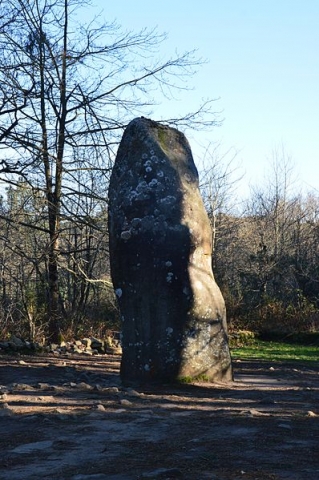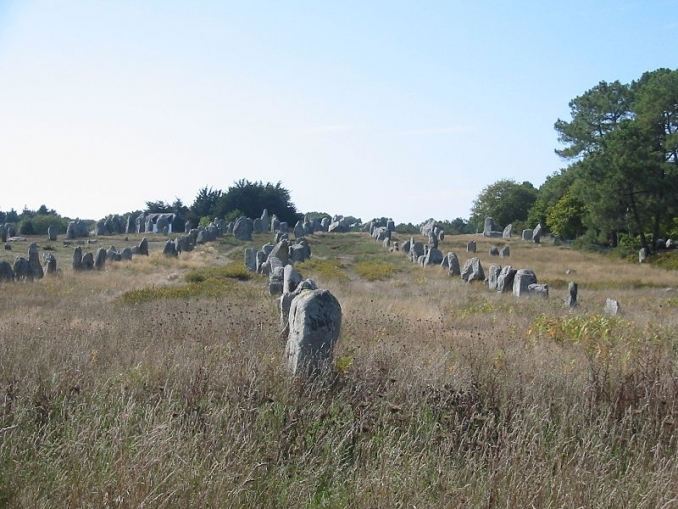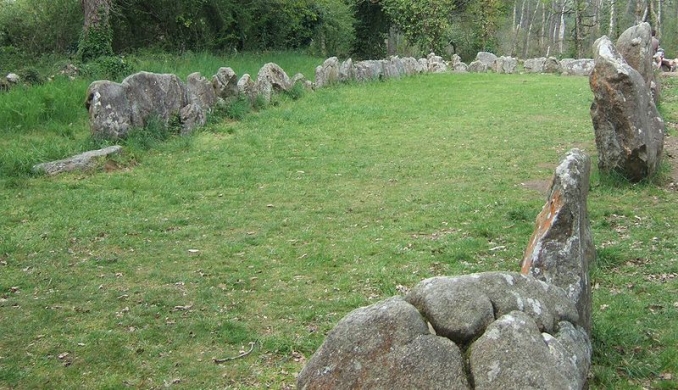Géant du Manio standing stone in Brittany

Carnac (Breton: Karnag) is beside the Gulf of Morbihan (Breton: Ar Mor Bihanon) in the south coast of Brittany (Breton: Breizh). It is home to one of the largest megalithic complexes in Europe with over 3000 standing stones. It is famous for the unique way in which these stones are aligned in rows. They are of differing sizes and each granite stone seems to have been erected in the place where it was excavated. There are three large groups of stones Ménec, Kermario and Kerlescan.
Menec has eleven groups of menhirs in the alignment covering a distance of about 3,820 by 330 feet. The stones vary in height from about 13 feet down to 2 feet. There are cromlechs to the east and west of the site. Kermerio Alignements is made up of 1029 stones in ten columns that reach a distance of about 4,300 feet. Kerlescan Allignment is east from Menec and Kermerio sites. There are thirteen lines consisting of 555 stones varying in height from about 13 feet to 2 feet 7 inches. They cover a length of approximately 2,600 feet and at the west of the alignment is a stone circle made up of 39 stones.
However, one of the most impressive standing stones in Carnac is the Géant du Manio. This large menhir stands 6.5 meters high and is the largest standing stone on the Carnac alignment site. It stands alone about 45 - 50 meters from the Quadrilatère du Manio, which is a rectangular enclosure of a number of stones standing about 1 meter high. The Géant du Manio, impressive as it is now, is thought by some to have actually reached the height of 23 meters before erosion and lightning strikes. The suggested original mass has been estimated at 350 tonnes, this being the case the amount of effort in putting up the stone must have been huge.
As with other menhirs very little is known about the beliefs of those that erected them. It is thought they had a religious or cultural significance. Certainly they were very important and were created with great effort, care, skill and reverence. Many menhirs found across the Celtic lands are engraved with stunning megalithic art. It is also known that a signifcant number of ancient stones and tombs are placed in a way that look to the stars and capture moments of astronomical importance. The rising and setting of the sun and moon during the summer and winter equinoxes. Brittany is a Celic country that is known for its many ancient megalithic sites. Interestingly recent research into the age of megaliths in Brittany points to far older origin than originally thought, perhaps back to six to seven thousand years ago. The Cairn de Barnenez in Plouézoc’h in Morlaix ( Breton: Montroulez) in the north of Brittany is estimated to date from 5000 BC. This makes it 2000 years older than the Egyptian Pyramids. The stones at Carnac are thought to date from 4000BC.
Image above: Géant du Manio
Other images: Carnac and Quadrilatère du Manio







